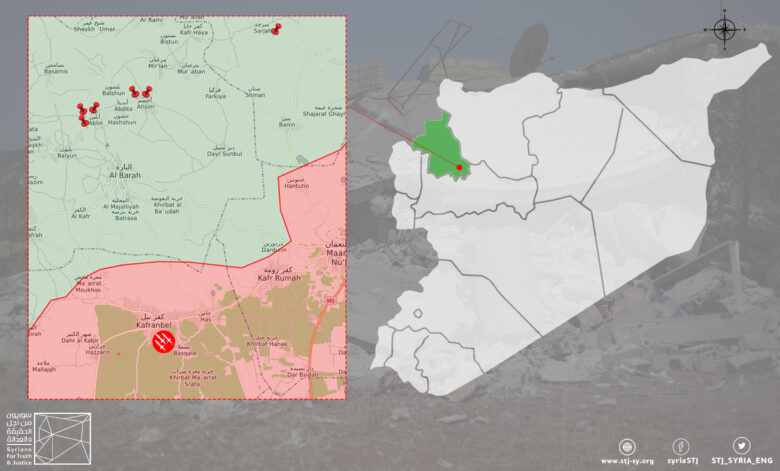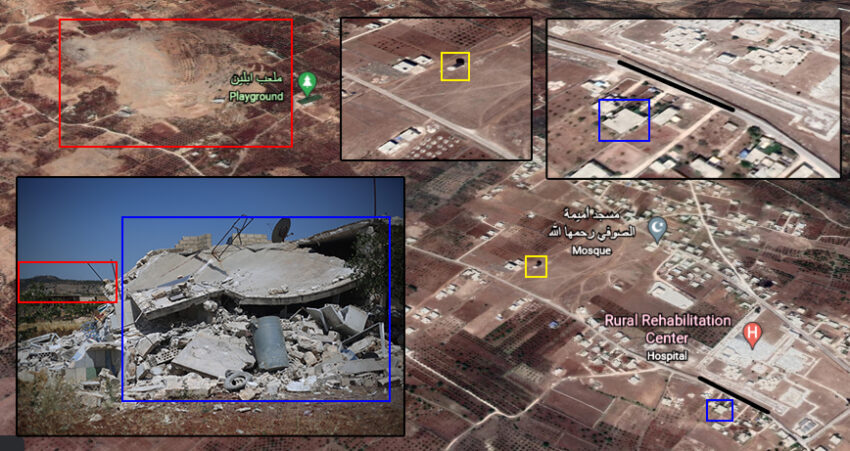Russian and Syrian government forces escalated their artillery attacks on Idlib province in early June 2021. This recent violent bombing campaign continued to the end of July 2021 and killed at least 44 persons—mostly civilians, among them at least 17 children and eight women. Additionally, the hostilities injured at least 30 persons, the majority of whom were women and children. The majority of the 44 documented deaths occurred during six fatal attacks on Mount Zāwiya in the southern countryside of Idlib. Russian and government forces launched these attacks from a joint military base.
The Violations Documentation Center in Syria (VDC) provided Syrians for Truth and Justice (STJ) with the names of 72 casualties of the recent attacks carried out by Russian and Syrian forces from 1 June to 31 July 2021. The death toll includes the victims of the attacks investigated in this report, as well as the victims of other strikes.
Notably, the extensive shelling by Russian and Syrian government forces disrupted a relative calm in Idlib which lasted nearly a year since a ceasefire agreement between Russia, which supports the Syrian government, and Turkey, which backs Syrian armed opposition groups and has established several military posts across Idlib province under the provisions of the Astana agreement.
However, the latest round of Astana Talks, held between Turkey, Russia, and Iran, on 7-8 July 2021, did little to stop the attacks. Extensive shelling preceded the Astana Talks and continued despite them, even as the three states agreed on the “need to maintain the de-escalation agreement [in Idlib].”
The recent hostilities in Idlib have garnered international attention. The United Nations (UN) expressed “deep concern” over escalating violence in northwestern Syria.[1] For his part, UNICEF Regional Director for the Middle East and North Africa, Ted Chaiban, said on 3 July that “this is just tragic. These attacks are the worst since a ceasefire was brokered in March last year. An escalation of violence will only result in cutting short the lives of more children.”[2]
The Russian-Syrian attacks, which intensified beginning in early July, mainly hit Mount Zāwiya, south of Idlib province. The targeted area is adjacent to the M4 International Highway and has significant strategic and military importance because it overlooks massive areas in the provinces of Hama and Idlib.
In addition to locating the targets of these extensive attacks, field researchers with STJ monitored the weapons Russian forces used during the attacks. Field researchers documented that Russian forces relied heavily on Russian-developed Krasnopol laser-guided artillery shells.[3] According to evidence, Russian forces located targets and controlled the shells using high-tech reconnaissance unmanned aerial vehicles (UAVs), which are known for their high precision. The laser-guided artillery systems and the advanced technology Russian forces used to locate targets suggest that the attacks on homes, rescue teams, paramedics, as well as civilian objects were likely deliberate and may amount to war crimes. All the attacks were launched from the jointly-controlled Syrian-Russian military base in Basakla village, near Kafr Nabl city, south of Idlib province.
Furthermore, field researchers observed that Syrian government and/or Russian forces used “double-tap attacks” in all six reported strikes. “Double-tap attacks” entail striking the same target twice, leaving a small-time interval between the first and second strike. In the interim period following the first strike, people gather at the attack site to find and aid victims – then are subsequently turned into victims themselves during a second strike. “Double-tap attack” methods potentially double the number of potential casualties, and in the case of the recent Idlib strikes, are responsible for high numbers of casualties and injuries.
This report draws on information collected by Idlib-based field researchers and five interviews conducted by STJ with eyewitnesses and sources, among them survivors, civilians, media activists, and military observatories. Additionally, the report provides open-source analysis of photographs and videos documenting the six attacks.

Image 1- A map locating the sites where the six reported attacks occurred, as well as the military base from where they were launched. Credit: STJ.
To read the report in full as a PDF, follow this link.
______________
[1] “UN Concerned over Escalating Violence in Northwestern Syria, Following Death of 7 Civilians, Including Children” (In Arabic), UN News, 23 July 2021, https://news.un.org/ar/story/2021/07/1080142 (last accessed: 31 July 2021).
[2] “Six Children killed and scores injured in attacks on three villages south of Idlib, Syria,” UNICEF, 3 July 2021, https://www.unicef.org/mena/press-releases/six-children-killed-and-scores-injured-attacks-three-villages-south-idlib-syria (last accessed: 31 July 2021).
[3] “Russian Weapon that Devours Tanks and Destroys Shelters” (in Arabic), Sputnik, 29 July 2021, https://arabic.sputniknews.com/military/201812101037378528-%D8%B3%D9%84%D8%A7%D8%AD-%D8%B1%D9%88%D8%B3%D9%8A-%D8%A7%D9%84%D8%AF%D8%A8%D8%A7%D8%A8%D8%A7%D8%AA/ (last accessed: 31 July 2021)

